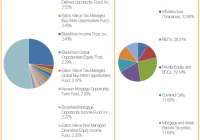Robo-Advisors Trump ETF Investments In Q3, But China May Hold The Key
Summary How we got here. Progress year-to-date. How the investments compare after the third quarter. What does the future hold? How we got here This series began with an article explaining that on January 23, I had invested $10,090 in Betterment, WealthFront, and the Vanguard Total Stock Market ETF (NYSEARCA: VTI ), with the intention of documenting their comparative performance. Some readers suggested the Robo-Advisors be compared to a broader field of investments; consequently, we added the Global X SuperDividend ETF (NYSEARCA: SDIV ) and the Vanguard FTSE Developed Markets ETF (NYSEARCA: VEA ). So, this is how the five investments are doing at the end of the third quarter. Progress Year-to-Date Looking at the chart, you can see that VEA got off to a good start, SDIV looked like it was going to do all right at first, then lost ground, and the two robo-advisors have been in a downward trajectory that, compared to the others looks more like a glide path than a crash landing. Finally, they were able to trump the others ending this quarter virtually tied for best outcome proving the adage: Any landing that the passengers walk away from is a good landing. (click to enlarge) How the investments compare after the third quarter Now that we’ve experienced a market downturn, the robo-advisor theory has been given a pretty good test. The real test will come with the next Black Swan. In our case, because we are nearing the end of the accumulation phase of our investment experience, the robo-advisors chose a conservative distribution of assets. Not surprisingly, they held their value better than the funds. Investment Q3 Closing Value Gain/Loss Percent Change Betterment 9,781.08 -$308.92 -3.16% SDIV 8,913.63 -1176.37 -13.20% VEA 9,527.92 -562.08 -5.90% VTI 9,463.48 -626.52 -6.62% WealthFront 9,576.03 -513.97 -5.37% What does the future hold? Pundits tell us that China did poorly in the third quarter and that China may not improve for the entire second half. This and certain exogenous factors promise a lackluster outlook for the real economy, but who is so bold as to predict the outlook for the investment markets? Whichever way it goes, I am kind of glad that some of my readers browbeat me into expanding the experiment adding the hedging properties of diversification. I feel pretty confident in predicting that automated asset managers will continue to attract investors and that traditional brokerages will continue to try to get out in front of the potential threat by offering automated investment advice. Additional disclosure: The opinions in this article are for informational purposes only and should not be construed as a recommendation to buy or sell the investments mentioned. Share this article with a colleague
